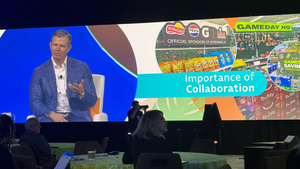New Symphony Consulting Food & Beverage Industry Report Predicts Accelerating Market Growth in 2011 and 2012New Symphony Consulting Food & Beverage Industry Report Predicts Accelerating Market Growth in 2011 and 2012
January 1, 2018
MIAMI BEACH, March 28, 2011 - The U.S. food and beverage market will continue its rebound in 2011 and 2012, as more shoppers believe the economy will improve and anticipate their personal financial situations and personal financial security will take a turn for the better. These results are tempered by projections that show price increases will act as the principal growth driver, and food and beverage market growth will trail that of the overall U.S. economy.
These were principal findings of a new Symphony Consulting Executive Briefing, "The U.S. Food and Beverage Market: 2010 Performance and Outlook for 2011 and 2012," announced today at SymphonyIRI's Summit 2011 conference, which is themed, "Gaining the Competitive Edge." Summit is taking place at the Fontainebleau Miami Beach, March 28-30. Information on Summit is available at www.sigsummit.com.
The study also reported on 2010 market performance, noting the U.S. food and beverage market slowed to 0.6 percent growth in 2010 as compared to 1.3 percent in 2009.
"As the economy continues to improve, shoppers are more likely to remain with a set of brands and retailers that they know delivers the value they expect," said Dr. Krishnakumar (KK) Davey, managing director, Symphony Consulting. "It is important for these companies to invest in gaining the most detailed understanding of their shoppers possible. To succeed, these manufacturers and retailers must innovate by continuously introducing new products, packaging, pricing, merchandising and promotion strategies, and customizing these initiatives to highly-discrete shopper microsegments."
Forecasting 2011 and 2012
SymphonyIRI's new Executive Briefing forecasts the U.S. food and beverage market to grow in the 1.0-1.5 percent range in 2011 and the 1.8- 2.2 percent range for 2012. This is significantly slower than the 3.6-3.9 percent CAGR anticipated for U.S. gross domestic product (GDP) by Moody's. Among surveyed shoppers, 38 percent anticipate their food and beverage spending will increase in 2011, while just 10 percent project their spending will decline.
The new research forecasts the drug, convenience and dollar store channels will enjoy the strongest growth, with CAGR of 4.7 percent, 3.5 percent and 2.6 percent, respectively, between 2010 and 2012. The convenience store channel, particularly sensitive to economic trends, is anticipated to exhibit rapid growth in 2011 and 2012, after a healthy rebound in 2010 over 2009. The mass/supercenter channel is expected to reverse its decline of 2010 with growth of approximately 2 percent in 2011 and 2012, driven by innovations, such as the expansion of P-Fresh format at Target and the creation of smaller store formats by Walmart with which it is entering new markets, such as urban areas and small towns.
On a regional basis, areas forecasted to enjoy the highest growth are ones that suffered the most precipitous declines during the last recession. The Northeast, Southeast and Great Lakes regions held dollar shares of 16 percent, 15 percent and 14 percent, respectively. Symphony Consulting forecasts the Northeast to grow at a rate between 1.5 percent and 1.9 percent, slightly faster than the U.S. market. The Southeast is anticipated to experience slower-than-average growth, in the range of 0.6-1.0 percent. Symphony Consulting believes the Great Lakes region represents a significant growth opportunity, and predicts growth of 3.0-3.4 percent in 2011 over 2010, and a gain 0.3 of a percentage point in its share of the national market.
"Because the economic recovery is, and will continue to be, uneven, CPG and retail leaders must identify and focus on market segments where growth is likely to occur over the coming months and years," added James Rushing, partner, Symphony Consulting. "While there are exciting opportunities for CPG and retail companies to attract new shoppers and increase shopper loyalty, there are still challenges ahead. Many shoppers expect their food and beverage spending to be flat or increase just slightly this year."
Looking Back at 2010
Symphony Consulting's Executive Briefing cites the improvement in the U.S. macroeconomic environment as the primary growth engine of the food and beverage market in 2010, accounting for approximately $1.6 billion in growth. Macroeconomic factors include, but are not limited to, changes in the consumer price index, GDP, gas prices and disposable income. Microeconomic factors, such as changes in pricing, distribution and merchandising, accounted for approximately $1 billion in growth.
Among macroeconomic factors, price inflation and increases in disposable income each accounted for approximately $1 billion in growth. Changes in distribution, more aggressive merchandising and pricing strategies added $1.4 billion, $800 million and $700 million, respectively, to growth. These factors were largely offset by rising prices, which increased the dollar value of sales, but decreased quantities purchased, and increased merchandising, which raised volume sold, but at the expense of dollar value.
About the Author
You May Also Like




